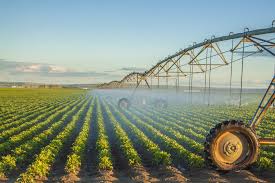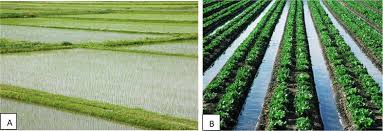Irrigation plays a vital role in crop sustenance and survival, and there is need for the farmer to be knowledgeable in it so that the quantity of water to apply is known in terms of water need of crops during short periods of drought or in the dry season.
The article focuses on the amount of water crops require during irrigation under normal conditions.
Read Also: Major Genetic Differences between Tropical and Temperate Livestock Breeds
Definition and Importance of Irrigation Requirement in Crop Farming

The irrigation requirement (IR) of a crop is the total amount of water that must be supplied by irrigation to a disease-free crop growing in a large field with adequate soil water and fertility and achieving full production potential under a given growing environment.
The irrigation requirement includes water used for crop consumptive use, maintaining a favourable salt balance within the root zone, and overcoming non-uniformity and inefficiencies of the irrigation system or equipment.
The irrigation requirement does not include water from natural sources such as rainfall that crops can effectively use. The irrigation requirement (IR) can be computed when the evapotranspiration (ET) is known using the equation:
IR = 100(Drz (θf – θi) + ET + L – Pe) / Ei
Where:
Drz = Depth of root zone (cm)
θf and θi = Soil moisture content by volume at the end (final) and beginning (initial) of the time interval being considered
L = Leaching requirement
ET = Evapotranspiration
Pe = Effective precipitation (rainfall)
Ei = Overall efficiency of irrigation in percentage (%)
Major Types of Irrigation Requirement in Crop Production
There are two types of irrigation requirement namely:
1. Net Irrigation Requirement (NR) for Optimal Crop Growth
Net irrigation requirement is that amount of irrigation water which is required to bring the soil moisture of the effective root zone to field capacity (FC).
The aim of irrigation is not to saturate the soil but to bring the soil to field capacity, and the amount of water required to achieve this is known as net irrigation requirement. Net irrigation can be calculated using the following equation:
D = (MF – MS) x BD x d / 100
Where:
D = Net amount of water to be applied
d = Effective root zone depth
MF = Moisture at field capacity
MS = Soil moisture before irrigation
BD = Bulk density
Worked Example on Net Irrigation Requirement
A soil has the following characteristics:
Field capacity = 30%
Effective root zone = 100cm
Bulk density = 1.325g/cm³
Actual soil moisture = 15%
Calculate the depth of water:
D = (MF – MS) x BD x d / 100
= (30 – 15) x 1.325 x 100 / 100
= 0.15 x 1.325 x 100
= 19.88cm (depth of water)
1 hectare = 10,000m²
Then for 1 hectare:
= 19.88 x 10,000 / 100
= 0.1988 x 10,000
= 1988m³ (water to be applied for 1 hectare)
Read Also: Crossbreeding as Tool for Tropical Livestock Improvement
2. Gross Irrigation Requirement (GR) for Complete Water Supply Planning

Gross irrigation requirement is the total amount of irrigation water to be diverted to the farm from the source. It includes net irrigation requirement and losses incurred during transportation and application.
Transportation losses include evapotranspiration, while application losses include runoff, deep percolation, seepage, transpiration, and uneven distribution of water.
Gross irrigation requirement can be calculated using the following equation:
GR = Net irrigation (NR) / Field efficiency of the system
Where:
GR = Gross irrigation requirement
NR = Net irrigation requirement
The calculation of irrigation requirement is important for efficient water use in an irrigation scheme. When irrigation requirement is not calculated and water is applied indiscriminately, it could leach nutrients or cause erosion, thereby reducing crop productivity and degrading the soil.
Do you have any questions, suggestions, or contributions? If so, please feel free to use the comment box below to share your thoughts. We also encourage you to kindly share this information with others who might benefit from it. Since we can’t reach everyone at once, we truly appreciate your help in spreading the word. Thank you so much for your support and for sharing!

